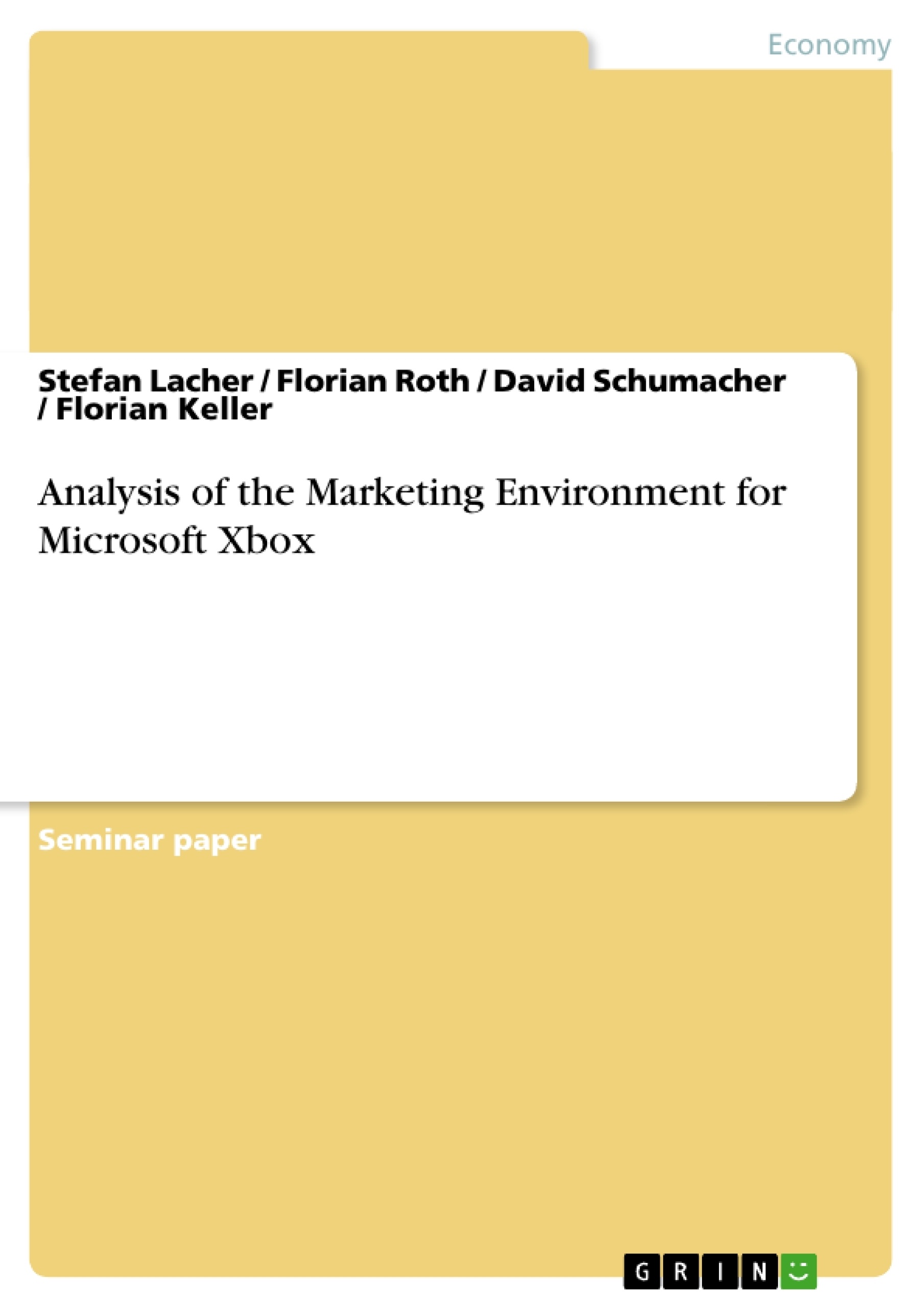What comes first to your mind when you hear the names Sony and Nintendo? Maybe you
associate them as the two huge players on the video console market which dominate this
segment. So what happens if the giant of the software industry, Microsoft, steps into a so far
protected territory and introduces a perfect planned marketing campaign that brings the green
Xbox-logo in everybody’s mind? Considering that Microsoft is a very aggressive and well
financially equipped company, therefore one of the most successful in the world, you can
expect a major showdown. But what will happen to the customer who should be the driving
force of the ma rketing effort of those players?
Contents
1 Introduction
2 Environmental Analysis
2.1 External Analysis
2.2 Internal Analysis
3 SWOT Analysis
3.1 Strengths
3.2 Weaknesses
3.3 Opportunities
3.4 Threats
4 Conclusion
5 Reference List
1 Introduction
What comes first to your mind when you hear the names Sony and Nintendo? Maybe you associate them as the two huge players on the video console market which dominate this segment. So what happens if the giant of the software industry, Microsoft, steps into a so far protected territory and introduces a perfect planned marketing campaign that brings the green Xbox-logo in everybody’s mind? Considering that Microsoft is a very aggressive and well financially equipped company, therefore one of the most successful in the world, you can expect a major showdown. But what will happen to the customer who should be the driving force of the marketing effort of those players?
2 Environmental Analysis
Microsoft like any large company is exposed and heavily influenced by the industrial environment. This environment can be analysed both externally and internally.
2.1 External Analysis
The external analysis is determined by various factors, which affect companies from the outside and can not directly be influenced by them (Thompson & Strickland 2003, pp.72-112). The external analysis can be divided into a closer (industry-) and a broader (macro-) environment (see figure 1).
Figure 1: External Environment (Thompson & Strickland 2003, p. 74)
The industry environment includes customers and competitors (compare 5-forces-modell by Porter) which are specific for the industry sector. The macro-environment includes political, legal, ecological, technological and social conditions which are mainly the same for all companies, regardless of their sector (Baker 2000, pp.171-187).
2.2 Internal Analysis
Through the external analysis which is described in section 2.1 of this report it is possible to identify opportunities and threats. The extent to which these chances and risks can be managed depends on the company’s preparation for challenges on the market: its strengths and weaknesses. The ultimate cause of those strengths and weaknesses are the special competences of a company – its resources and capabilities, which can be contributed to the competition (Aaker 1998, pp. 114-128). The value chain by Porter is one model to classify the different resources and capabilities (see figure 2).
Figure 2:Porter’s value chain (Michael J. Baker 2000, p. 203)
3 SWOT Analysis
A SWOT analysis is advantageous for presenting the database derived from the internal and external analysis in a systematic and concise manner (Kotabe & Helsen 1998, pp. 236-237). “SWOT analysis is grounded in the basic principle that strategy-making efforts must aim at producing a good fit between a company’s resource capability (as reflected by its balance of resources strengths and weaknesses) and its external situation (as reflected by industry and competitive conditions, the company’s own market opportunities, and specific external threats to the company’ profitability and market standing)” (Thompson & Strickland 2003, p. 117).
3.1 Strengths
One of Microsoft’s main strengths is definitely its financial power. If you compare the operating income to sales of the year 2003 Sony achieved a ratio of 3.31% (Sony Corp. 2003, p. 63) which is almost 14 times lower than the Microsoft figure of 45.75% (Microsoft Corp. 2003, ) and Nintendo has at least a ratio of 22,50% (Nintendo Co. Ltd 2003, p. 48).
Such dominance allowed for the $500m investment in marketing the Xbox and corresponding loss of $100 - $150 per machine sold (Anon 2001).
Although Microsoft was entering a new market they did not have to face the problem that the company was not known by customers. Microsoft is the second most famous and valuable brand name in the world (Business week 08/04/2003, pp. 72-78). Therefore it could use the advantage of being associated with high quality and perfect performance to achieve the customer’s trust.
[...]
- Arbeit zitieren
- Stefan Lacher (Autor:in), Florian Roth (Autor:in), David Schumacher (Autor:in), Florian Keller (Autor:in), 2004, Analysis of the Marketing Environment for Microsoft Xbox, München, GRIN Verlag, https://www.grin.com/document/24495
-

-

-

-
Laden Sie Ihre eigenen Arbeiten hoch! Geld verdienen und iPhone X gewinnen. -

-
Laden Sie Ihre eigenen Arbeiten hoch! Geld verdienen und iPhone X gewinnen. -

-
Laden Sie Ihre eigenen Arbeiten hoch! Geld verdienen und iPhone X gewinnen. -

-
Laden Sie Ihre eigenen Arbeiten hoch! Geld verdienen und iPhone X gewinnen. -

-
Laden Sie Ihre eigenen Arbeiten hoch! Geld verdienen und iPhone X gewinnen.

